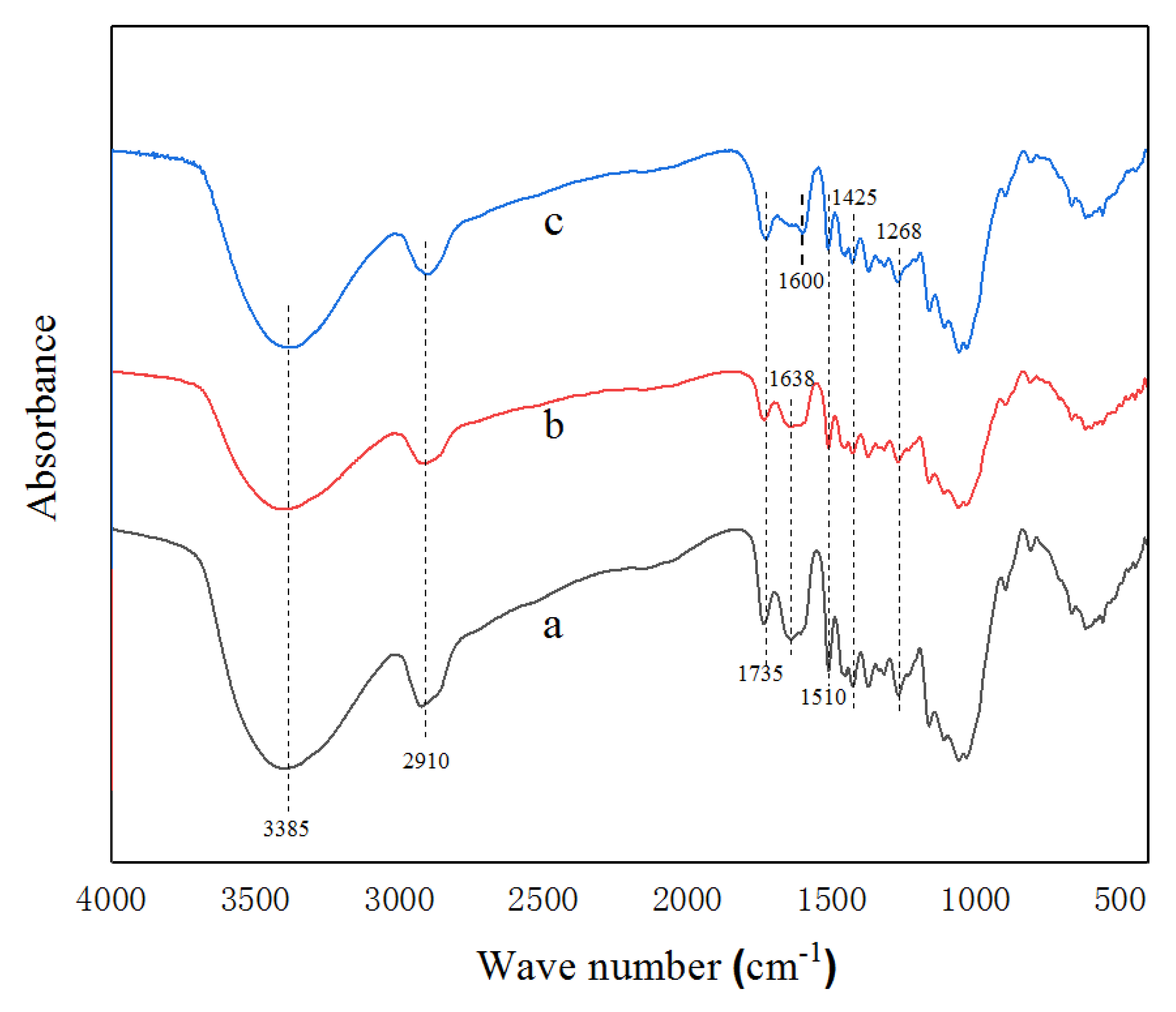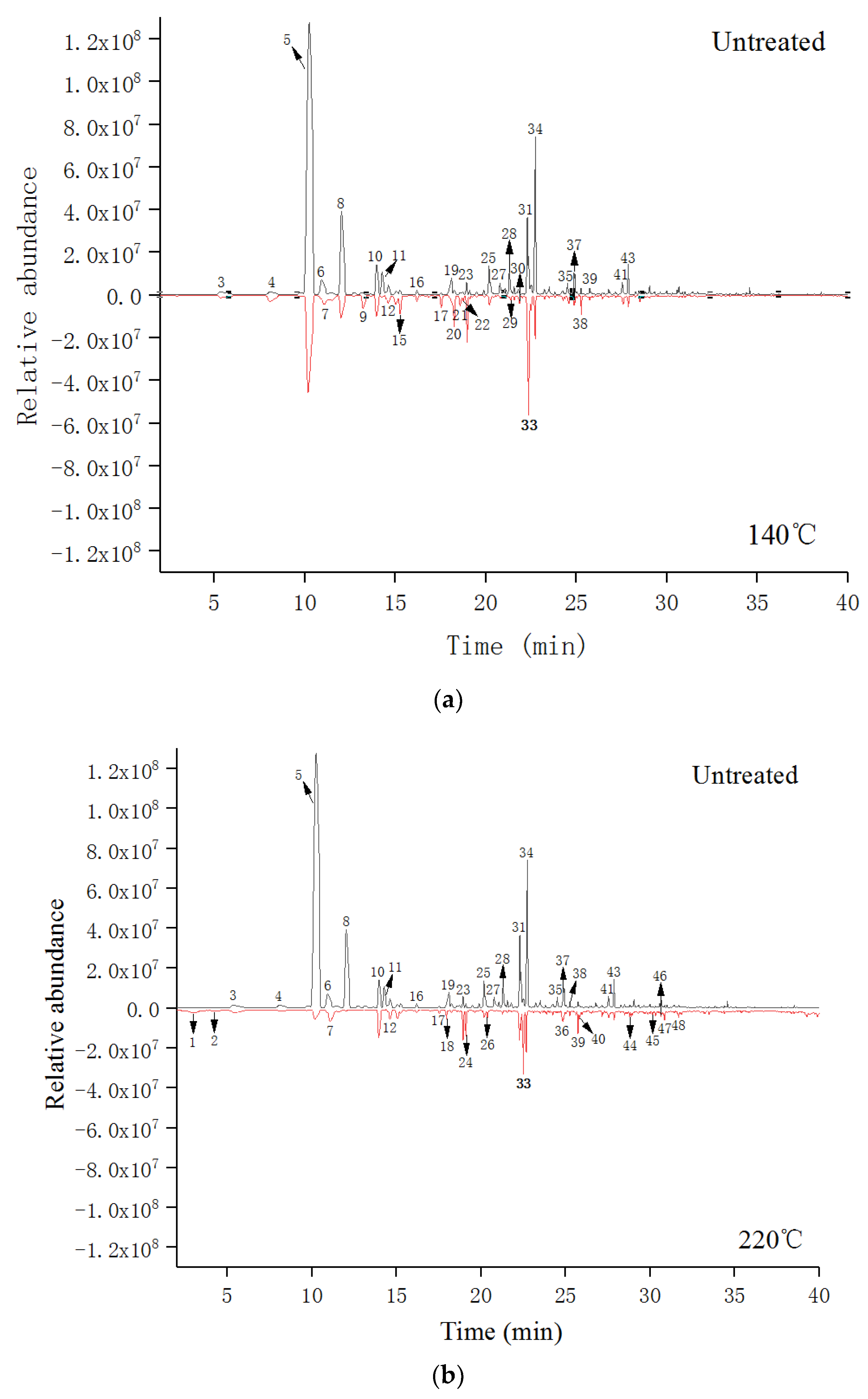Released Volatile Organic Compounds in Southern Yellow Pine before and after Heat Treatment
Abstract
:1. Introduction
2. Materials and Methods
2.1. Materials
2.2. Preparation of Wood Samples
2.3. Heat Treatment
2.4. Fourier Transform Infrared Spectroscopy
2.5. Gas Chromatography-Mass Spectrometer
2.5.1. Adsorption
2.5.2. Chromatographic Conditions
2.5.3. Mass Spectrometry
2.5.4. Qualitative and Quantitative Analyses of Compounds
3. Results and Discussion
3.1. FTIR Analysis
3.2. Identification of VOCs
4. Conclusions
Author Contributions
Funding
Acknowledgments
Conflicts of Interest
References
- Filipy, J.; Rumburg, B.; Mount, G.; Westberg, H.; Lamb, B. Identification and quantification of volatile organic compounds from a dairy. Atmos. Environ. 2006, 40, 1480–1494. [Google Scholar] [CrossRef]
- Kasper, P.L.; Mannebeck, D.; Oxbøl, A.; Nygaard, J.V.; Hansen, M.J.; Feilberg, A. Effects of dilution systems in olfactometry on the recovery of typical livestock odorants determined by PTR-MS. Sensors 2017, 17, 1859. [Google Scholar] [CrossRef] [PubMed]
- Tong, L. The Produce Mechanism and Prevention of VOCs Larix gmelini Rupr-Wood during Drying; Beijing Forestry University: Beijing, China, 2004. [Google Scholar]
- Liu, R.; Wang, C.; Huang, A.M.; Lv, B. Characterization of odors of wood by gas chromatography-olfactometry with removal of extractives as attempt to control indoor air quality. Molecules 2018, 23, 203. [Google Scholar] [CrossRef] [PubMed]
- Liu, R.; Wang, C.; Huang, A.M.; Lv, B. Identification of odorous constituents for Southern yellow pine and China fir woods: Effects of extractives removal. Anal. Methods 2018, 10, 2115–2122. [Google Scholar] [CrossRef]
- Wang, X.; Chen, X.; Xie, X.; Wu, Y.; Zhao, L.; Wang, S. Effects of thermal modification on the physical, chemical and micromechanical properties of Masson pine wood (Pinus massoniana Lamb.). Holzforschung 2018. [Google Scholar] [CrossRef]
- Hao, Y.; Pan, Y.; Du, R.; Wang, Y.; Chen, Z.; Zhang, X.; Wang, X. The Influence of a thermal treatment on the decay resistance of wood via FTIR analysis. Adv. Mater. Sci. Eng. 2018, 2018, 8461407. [Google Scholar] [CrossRef]
- Chung, H.; Park, Y.; Yang, S.Y.; Kim, H.; Han, Y.; Chang, Y.S.; Yeo, H. Effect of heat treatment temperature and time on sound absorption coefficient of Larix kaempferi, wood. J. Wood Sci. 2017, 63, 575–579. [Google Scholar] [CrossRef]
- Poncsák, S.; Shi, S.; Kocaefe, D.; Miller, G. Effect of thermal treatment of wood lumbers on their adhesive bond strength and durability. J. Adhes. Sci. Technol. 2007, 21, 745–754. [Google Scholar] [CrossRef]
- Esteves, B.; Videira, R.; Pereira, H. Chemistry and ecotoxicity of heat-treated pine wood extractives. Wood Sci. Technol. 2011, 45, 661–676. [Google Scholar] [CrossRef]
- Iordache, A.; Culea, M.; Gherman, C.; Cozar, O. Characterization of some plant extracts by GC-MS. Nucl. Instrum. Methods Phys. Res. Sect. B 2009, 267, 338–342. [Google Scholar] [CrossRef]
- Mangindaan, B.; Matsushita, Y.; Aoki, D.; Yagami, S.; Kawamura, F.; Fukushima, K. Analysis of distribution of wood extractives in gmelina arborea by gas chromatography and time-of-flight secondary ion mass spectrometry. Holzforschung 2017, 71, 299–305. [Google Scholar] [CrossRef]
- Chang, Y.L.I.; Zu-Guang, L.I.; Zhou, S.Y.; Ye, D.F.; Mo, W.M. GC-MS/MS determination of safrole in essence and perfume with HS-SPME. Phys. Test. Chem. Anal. 2013, 49, 216–218. [Google Scholar]
- Korkmaz, A.; Hayaloglu, A.A.; Atasoy, A.F. Evaluation of the volatile compounds of fresh ripened Capsicum annuum and its spice pepper (dried red pepper flakes and isot). LWT-Food Sci. Technol. 2017, 84, 842–850. [Google Scholar] [CrossRef]
- Pereira, P.A.P. HS-SPME/GC-MS Analysis of VOC and multivariate techniques applied to the discrimination of Brazilian varieties of mango. Am. J. Anal. Chem. 2014, 5, 157–164. [Google Scholar]
- Plum, A.; Engewald, W.; Rehorek, A. Rapid qualitative pyrolysis GC-MS analysis of carcinogenic aromatic amines from dyed textiles. Chromatographia 2003, 57, S243–S248. [Google Scholar] [CrossRef]
- Zhu, H.; Lu, Z.; Cai, J.; Li, J.; Gao, L. Development of a headspace–SPME–GC/MS method to determine volatile organic compounds released from textiles. Polym. Test. 2009, 28, 521–527. [Google Scholar] [CrossRef]
- Manninen, A.M.; Pasanen, P.; Holopainen, J.K. Comparing the VOC emissions between air-dried and heat-treated Scots pine wood. Atmos. Environ. 2002, 36, 1763–1768. [Google Scholar] [CrossRef]
- Sivonen, H.; Maunu, S.L.; Sundholm, F.; Jämsä, S.; Viitaniemie, P. Magnetic resonance studies of thermally modified wood. Holzforschung 2002, 56, 648–654. [Google Scholar] [CrossRef]
- Tjeerdsma, B.F.; Militz, H. Chemical changes in hydrothermal treated wood: FTIR analysis of combined hydrothermal and dry heat-treated wood. Holz als Roh-und Werkstoff 2005, 63, 102–111. [Google Scholar] [CrossRef]
- Özgenç, Ö.; Durmaz, S.; Boyaci, I.H.; Eksi-Kocak, H. Determination of chemical changes in heat-treated wood using ATR-FTIR and FT Raman spectrometry. Spectrochim. Acta Part A Mol. Biomol. Spectrosc. 2017, 171, 395–400. [Google Scholar] [CrossRef] [PubMed]
- Unsal, O.; Ayrilmis, N. The effect of steaming on equilibrium moisture content in beech wood (Fagus orientalis Lipsky). For. Prod. J. 2004, 54, 90–93. [Google Scholar]
- Xian, J.L.I.; Liu, Y.; Gao, J.M.; Wu, Y.Q.; Yi, S.L.; Wu, Z.P. Characteristics of FTIR and XRD for wood with high-temperature heating treatment. J. Beijing For. Univ. 2009, 31, 104–107. [Google Scholar]
- Wang, S.; Wang, K.; Liu, Q.; Gu, Y.; Luo, Z.; Cen, K.; Fransson, T. Comparison of the pyrolysis behavior of lignins from different tree species. Biotechnol. Adv. 2009, 27, 562–567. [Google Scholar] [CrossRef] [PubMed]
- Sundqvist, B.; Karlsson, O.; Westermark, U. Determination of formic-acid and acetic acid concentrations formed during hydrothermal treatment of birch wood and its relation to colour, strength and hardness. Wood Sci. Technol. 2006, 40, 549–561. [Google Scholar] [CrossRef]
- Qu, B.X.; Zhu, L.H. Development and application prospect of heat-treated wood at home and abroad. Hebei J. For. Orchard Res. 2008, 3, 013. [Google Scholar]
- Inoue, M.; Norimoto, M.; Tanahashi, M.; Rowell, R.M. Steam or heat fixation of compressed wood. Wood Fiber Sci. 1993, 25, 224–235. [Google Scholar]
- Bing-Wen, D.F.; Rong, H.U. Analysis of volatile oil of aralia continentalis. Bull. Bot. Res. 2001, 1, 027. [Google Scholar]




| Label | SP |
|---|---|
| Wood | Southern yellow pine |
| Scientific name | Pinus spp. |
| Density (g cm−3) | 0.49–0.53 |
| Place of origin | Texas, USA |
| Water content (%) | 8~12 |
| Length | 1500 mm |
| Condition of storage | 10–40 °C, 30–70% RH, for one year |
| Wave Number | Functional Groups |
|---|---|
| 3385 | OH |
| 2910 | CH3-CH2-(cellulose) |
| 1735 | C=O (hemicellulose) |
| 1638 | C=C (conjugated carbonyl groups in lignin) |
| 1600 | A benzene ring skeleton (lignin) |
| 1510 | Aromatic ring skeleton retractable vibration |
| 1425 | C-H plane deformation (aromatic ring skeleton) |
| 1268 | C–O (guaiacyl ring in lignin) |
| Group | Compounds |
|---|---|
| Alcohols | Ethanol; 1-Octanol; Exo-fenchol; (−)-Trans-pinocarveol; 4,6,6-Trimethylbicyclo[3.1.1]hept-3-en-2-ol; (+)-Alpha-terpineol(p-menth-1-en-8-ol); 1,7,7-Trimethyl-acetate-endo-bicyclo[2.2.1]heptan-2-ol |
| Aromatics | Benzene; Methyl(1-methylethyl)-benzene; P-cymene; Benzene; 1-Methoxy-4-(2-propenyl)-benzene |
| Acids | Acetic acid; Hexanoic acid; Cyclopentaneundecanoic acid; Heptanoic acid; (−)-(1s,2r,4r)-beta-fenchol; Octanoic acid; Nonanoic acid |
| Aldehydes | Hexanal; 2-Furancarboxaldehyde; Benzaldehyde; Octanal; (E)-2-octenal; Nonana; (Z)-6-nonenal; (Z)-2-decenal |
| Alkenes | 2,6,6-Trimethyl-bicyclo[3.1.1]hept-2-ene;Beta-pinene; |
| 1-Methyl-4-(1-methylethenyl)-(s)-cyclohexene; 3-Isopropyl-6-methylene-1-cyclohexene; | |
| 3-Methyl-6-(1-methylethylidene)-cyclohexene; Cetene; | |
| 4,11,11-Trimethyl-8-methylene-[1r-(1r*,4e,9s*)]-bicyclo[7.2.0]undec-4-ene | |
| Alkanes | 2,2-Dimethyl-3-methylene-bicyclo[2.2.1]heptane; |
| Dodecane; Tridecane; Pentadecane; 3-Methyl-tridecane; Heptadecane; Undecyl-cyclopentane; 2-Methyl-hexadecane; N-nonylcyclohexane; 3-Methyl-pentadecane; Hexadecane | |
| Miscellaneous | 2-Pentyl-furan; 2-Nonanone; 2-Methoxy-phenol; 1,3,3-Trimethylbicyclo[2.2.1]hept-2-yl acetate # |
| Peak Number | RT (min) | Compounds | Percentage (%) * | ||
|---|---|---|---|---|---|
| Untreated | 140 °C | 220 °C | |||
| 1 | 2.95 | Ethanol | — | — | 0.81 |
| 2 | 4.21 | Benzene | — | — | 0.76 |
| 3 | 5.37 | Acetic acid | 0.51 | 1.09 | 2.51 |
| 4 | 8.07 | Hexanal | 0.68 | 2.52 | 1.06 |
| 5 | 10.25 | 2,6,6-Trimethyl-bicyclo[3.1.1]hept-2-ene | 49.19 | 24.37 | 5.3 |
| 6 | 10.93 | 2,2-Dimethyl-3-methylene-bicyclo[2.2.1]heptane | 2.26 | — | 0.44 |
| 7 | 11.06 | 2-Furancarboxaldehyde | — | 4.66 | 5.81 |
| 8 | 12.04 | Beta-pinene | 9.61 | 5.05 | — |
| 9 | 13.22 | 2-Pentyl-furan | — | 2.4 | 0.17 |
| 10 | 13.97 | 1-Methyl-4-(1-methylethenyl)-(s)-cyclohexene | 2.48 | 3.45 | 4.66 |
| 11 | 14.28 | 3-Isopropyl-6-methylene-1-cyclohexene | 1.78 | — | — |
| 12 | 14.60 | Methyl(1-methylethyl)-benzene | — | — | 2.82 |
| 13 | 14.62 | P-cymene | 0.86 | 1.55 | |
| 14 | 15.05 | Benzaldehyde | — | 1.89 | 2.8 |
| 15 | 15.27 | Octanal | — | 2.45 | 0.77 |
| 16 | 16.19 | 3-Methyl-6-(1-methylethylidene)-cyclohexene | — | 0.64 | 0.51 |
| 17 | 17.54 | 1-Methyl-4-(1-methylethenyl)-benzene | — | 1.26 | 0.64 |
| 18 | 17.96 | Hexanoic acid | — | — | 1.18 |
| 19 | 18.20 | (E)-2-octenal | 1.65 | — | 0.32 |
| 20 | 18.26 | Cyclopentaneundecanoic acid | — | 4.02 | — |
| 21 | 18.57 | 1-Octanol | — | 1.29 | 0.14 |
| 22 | 18.74 | 2-Nonanone | — | 0.56 | 0.06 |
| 23 | 18.94 | Nonanal | 0.67 | 3.67 | 4.37 |
| 24 | 19.10 | Dodecane | — | — | 3.5 |
| 25 | 20.20 | Exo-fenchol | 1.81 | 1.23 | 0.88 |
| 26 | 20.37 | 2-Methoxy-phenol | — | — | 0.98 |
| 27 | 20.78 | (−)-Trans-pinocarveol | 1.12 | 0.34 | 0.23 |
| 28 | 21.30 | 4,6,6-Trimethylbicyclo[3.1.1]hept-3-en-2-ol | 1.62 | — | — |
| 29 | 21.38 | Heptanoic acid | — | 0.58 | 0.43 |
| 30 | 21.85 | (Z)-6-nonenal | — | 0.76 | — |
| 31 | 22.26 | 1-Methoxy-4-(2-propenyl)-benzene | 4.87 | 12.39 | 4.27 |
| 32 | 22.34 | 1,3,3-Trimethylbicyclo[2.2.1]hept-2-yl acetate | — | — | 2.8 |
| 33 | 22.50 | Tridecane | — | — | 5.26 |
| 34 | 22.74 | (+)-Alpha-terpineol(p-menth-1-en-8-ol) | 6.83 | 2.93 | 2.07 |
| 35 | 24.52 | Octanoic acid | 0.57 | 0.93 | 0.13 |
| 36 | 24.79 | 3-Methyl-tridecane | — | — | 1 |
| 37 | 24.88 | 1,7,7-Trimethyl-acetate-endo-bicyclo[2.2.1]heptan-2-ol | 1.44 | 0.74 | 0.6 |
| 38 | 25.27 | (Z)-2-decenal | — | 1.1 | 0.45 |
| 39 | 25.73 | Heptadecane | 0.50 | 0.15 | 2.36 |
| 40 | 25.80 | Cetene | — | — | 0.89 |
| 41 | 27.54 | Nonanoic acid | 0.62 | 0.95 | 0.28 |
| 42 | 27.54 | Undecyl-cyclopentane | — | — | 0.98 |
| 43 | 27.87 | 4,11,11-Trimethyl-8-methylene-[1r-(1r *,4e,9s *)]-bicyclo[7.2.0]undec-4-ene | 1.03 | 0.86 | 0.98 |
| 44 | 28.78 | Pentadecane | — | — | 0.53 |
| 45 | 30.31 | 2-Methyl-hexadecane | — | — | 0.6 |
| 46 | 30.64 | N-nonylcyclohexane | — | — | 0.67 |
| 47 | 30.85 | 3-Methyl-pentadecane | — | — | 0.87 |
| 48 | 31.68 | Hexadecane | — | — | 0.63 |
© 2018 by the authors. Licensee MDPI, Basel, Switzerland. This article is an open access article distributed under the terms and conditions of the Creative Commons Attribution (CC BY) license (http://creativecommons.org/licenses/by/4.0/).
Share and Cite
Wang, C.; Wang, Z.; Qin, Y.; Yin, X.; Huang, A. Released Volatile Organic Compounds in Southern Yellow Pine before and after Heat Treatment. Int. J. Environ. Res. Public Health 2018, 15, 2579. https://doi.org/10.3390/ijerph15112579
Wang C, Wang Z, Qin Y, Yin X, Huang A. Released Volatile Organic Compounds in Southern Yellow Pine before and after Heat Treatment. International Journal of Environmental Research and Public Health. 2018; 15(11):2579. https://doi.org/10.3390/ijerph15112579
Chicago/Turabian StyleWang, Chen, Zhiping Wang, Ye Qin, Xiaoqian Yin, and Anmin Huang. 2018. "Released Volatile Organic Compounds in Southern Yellow Pine before and after Heat Treatment" International Journal of Environmental Research and Public Health 15, no. 11: 2579. https://doi.org/10.3390/ijerph15112579





